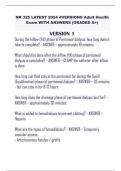Essay
Unit 9: IT Project Management - Assignment 1 - (Learning Aim A) (All Criterias Met)
- Course
- Institution
This essay is a distinction-level work for Unit 9: IT Project Management - Assignment 1 - Learning Aim A. You can efficiently work on your assignment by following my layout. in order to achieve the best grade (Distinction). All of the following criteria is met in this document ‣P1 - Explain, ...
[Show more]












